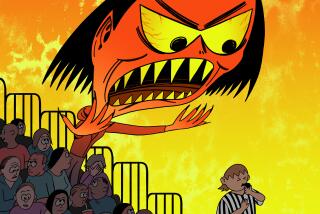Parents Urged to Know Injuries, Treatments
- Share via
BALTIMORE — The ankle turned in ballet class or the knee jammed on the soccer field may be “oh, nothing.” Then again, it may be something.
Parents need to know the difference.
With physical education classes gearing up and fall sports in full swing, youngsters are apt to be straining and spraining, pulling and pinching. Even one of America’s favorite passive pastimes, Nintendo, can bring injury and pain to its players.
“Any type of activity that is repetitive . . . stresses a single joint and can result in injury,” says Diane Runkles, a physical therapist and mother of two boys.
Some children respond to stress and injury by moaning and groaning; others try to ignore the whole thing.
Parents need to know what to pay attention to.
“No injury is too small to discuss, but not every injury needs to be treated,” Runkles says.
There are three signs of injury: pain, swelling and elevated temperature around the injured joint. If any of these conditions persist, it’s time for treatment, Runkles says.
Treatment for common sports injuries is usually rest and ice for the first 24 to 48 hours, she says. If the swelling does not go down, consult a doctor.
The most common injuries from soccer, lacrosse and basketball are to knees and ankles, Runkles says. Football players are also subject to back and neck problems.
Ballet, “a very strenuous sport,” demands flexibility, posture control and training, Runkles says. And very young children usually do not have the strength to “come totally up on their toes repeatedly”; that is why toe dancing should be avoided until a child is 11 or 12.
Some pain results not from a specific injury but from overdoing: swimming too many laps without conditioning or running too many miles without a proper warm-up.
“The key with children is prevention,” Runkles says. That starts with coaches and teachers who know that “a child needs to warm up before any form of exercise.”
“Children need to have a certain amount of strength and a certain amount of flexibility” for sports and physical education. “If a parent or a coach or teacher can recognize weakness or lack of flexibility,” many injuries can be prevented, she says.
Because some teachers and intramural coaches--often volunteering parents--have “limited medical experience,” Runkles adds, this weakness or lack of development may go unnoticed, causing a child harm.
“I encourage children to be active,” Runkles says. “They are ready . . . to be involved in some sort of sport by age 5. But they should be supervised.”
And they should also be told “to listen to their body.” It will tell them when they have done too much. And youngsters should also be instructed “to let parents and coaches know when they hurt.”
“ ‘No pain, no gain’ is totally wrong” when it comes to children and sports, Runkles says.
Distributed by the Los Angeles Times-Washington Post News Service.


